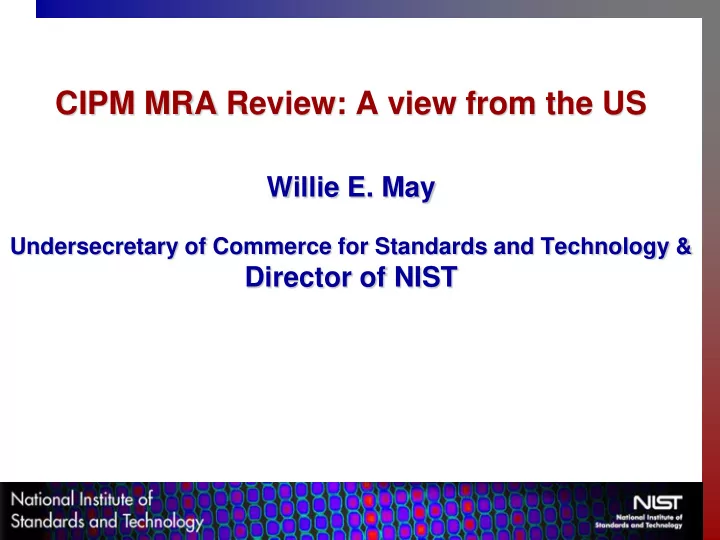

CIPM MRA Review: A view from the US Willie E. May Undersecretary of Commerce for Standards and Technology & Director of NIST
NIST’s Position on the Future of the CIPM MRA From NIST’s perspective: The CIPM MRA should be a means for: NMIs to document and vet the capabilities they maintain to underpin the Measurement Services they provide to Customers. Customers to assess the degree of comparability of a given service across the NMI/DI community. 3
Context NIST is the National Metrology Institute for the US – one of the original signatories of the CIPM MRA The US currently has no Designated Institutes. We: have active participants in all CIPM Consultative Committees are a member of the SIM Regional Metrology Organization (RMO) currently have 2028 CMCs listed in the KCDB have participated in ~ 380 KCs; coordinating ~ 80 have participated in ~ 70 supplementary comparisons (through SIM); coordinating ~ 25 provide following Measurement Services: – Standard Reference Materials: • ~ 1,300 products available • ~ 30,000 units sold per year – Calibration tests: ~ 18,000 tests per year – Standard Reference Data • ~ 100 different types • ~ 6,000 units sold per year • ~ 226 million data downloads per year – Laboratory accreditations: ~ 800 accreditations of testing and calibrations laboratories per year via NIST NVLAP
We have leveraged our Participation in CIPM MRA Activities to better serve our customers Documented degree of equivalence of measurement capabilities (that could be used to identify collaborators in delivery of NIST measurement services) EU Korea UK US Germany ERM DA251a 10 DMR 263a Relative Degeres of Equivalence, % ERM DA252a ERM DA253a ERM DA250a RELA 1/05 KS B RELA 1/05 KS A Creatinine 2 SRM 967a II 111 01 01A SRM 967a I 5 Creatinine 1 SRM 909b II 111 01 02A 111 01 03A 111 01 04A Comparison of value- 0 assigned CRMs for Creatinine in Serum SRM 909b I that could be used to better -5 manage NIST SRM renewal activities CCQM-K80 -10 M S C M T B S G S T A I I I N P R L N N K E C
Leveraging NIST Participation in CIPM MRA Activities to better serve our customers CCT K7 – Triple Point of Water Comparison 200 Measurement science was advanced through the CCT-K7 100 comparison (NMI - mean) / µK Results were in less agreement 0 than anticipated Cause identified as variations in −100 isotopic composition of the water New methodology developed that −200 NIST NMIJ NMi-VSL NPL NRC SMU UME BIPM BNM CEM CENAM CSIR CSIRO IMGC IPQ KRISS MSL NIM PTB SPRING VNIIM improved agreement by 40% International acceptance of commercial standards enabled by key comparison • NIST transferred measurement technology to Fluke • Enabled Fluke to be a world leader in supplying a critical commercialized temperature standard
NIST observations on the future implementation of the MRA: NMIs should always be major beneficiaries of the CIPM MRA. They provide the resources (CMCs, Key Comparisons of capabilities, maintenance and reviews of Quality Systems etc). The business case for NIST to resource our continued involvement in the MRA is that it provides U.S. Customers a means for objectively assessing the quality and comparability of measurement and calibration services provided by other NMIs. We recognize the benefits of the data in the KCDB to Accrediting Bodies, but these benefits should be ancillary in intent! – The NMIs should work to ensure that while these ancillary benefits are freely available to everyone, the needs of these ancillary beneficiaries should not be the major drivers of CIPM MRA activities. – The NMIs (taken collectively) cannot afford to support any additional work that would lead to expanding the use of the CIPM MRA for purposes of organizations other than those developed for the NMIs and their customers. The KCDB should not be a complete documentation of all of the capabilities of participating NMIs; but rather those capabilities that underpin the delivery of services offered to customers on a regular basis. If the CIPM MRA is effectively designed, implemented, and maintained for the NMIs, it will meet most of the relevant needs of other users. 7
MRA redesign should achieve the following Goals must support the international metrology needs of all NMIs (large, medium, small; well established, developing). require flat or reduced level of effort and investment by the NMIs to support the CIPM MRA. use simplified and streamlined processes for implementing and maintaining the various aspects of the CIPM MRA. provide easier and seamless access to and the interpretation of information developed under the CIPM MRA (such as calibration and measurement capabilities and key comparison results). Must maintain Quality of Data in Database 8
Recommendations CMCs should be only those that underpin services that are routinely offered to customers and are publically listed (e.g. NMI catalogs, websites, etc.). The review processes for CMC and quality systems should be simplified while maintaining rigor sufficient to maintain the quality of the information in the KCDB. Each Consultative Committee should identify and document a well-considered reduced set of key comparisons that sufficiently define a level of competence in a given technical area. These comparisons must be efficiently and effectively designed and implemented to achieve the goals of the CIPM MRA with reduced burden on the NMIs. RMOs should increase their focus on comparisons and other learning activities that demonstrate/improve the capabilities 9 of developing NMIs.
Recommend
More recommend